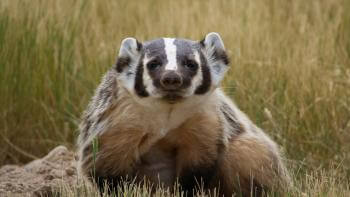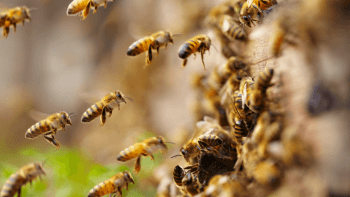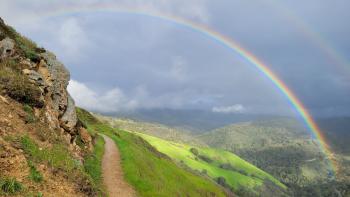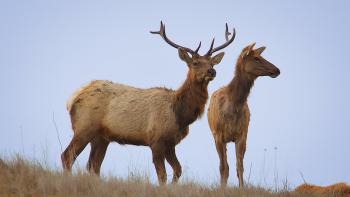The Season of Raptors
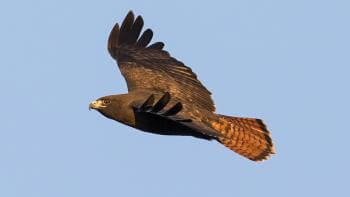
November is migration season for birds of prey, meaning you may see a variety of raptors during your next outdoor adventure. For birds of prey that migrate, this is the time of year when they start coming back to nest or “winter” in preparation for mating season in the spring. Keep reading to learn about the raptors found in Santa Clara Valley.
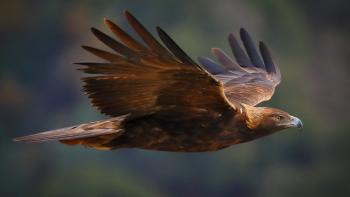
Golden eagle
These charismatic birds are found all over the South Bay, as they typically love grasslands and woodlands, and have large nests in wooded areas. In other parts of the country, these are migratory birds, flying south in the winter and north in the summer, but the ones locally are here year-round. Golden eagles are on the larger end of the spectrum – typically two to three feet long, with a wingspan of 6-8 feet -- and like to eat small mammals, reptiles, and fish.
Fun fact: These birds are often spotted at Sierra Vista Open Space Preserve.
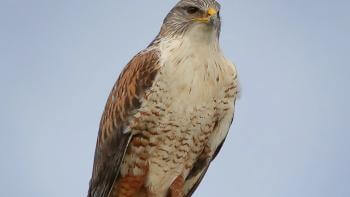
Ferruginous Hawk
These dapper fellows are known for their "pants" – or feathers that go all the way down to their ankles.
These broad-winged – or “buteo” hawks -- hawks prefer open oak savannas, woodlands, and grasslands and migrate through the South Bay in the winter. They like to hunt their prey in open areas where they can soar overhead and dive, and they prefer nesting in trees. A typical meal for ferruginous hawks will include small mammals, birds, snakes, or large insects.

Red-tailed hawk
In other parts of the country, these iconic raptors migrate north and south, but ours tend to stay local. Red-tailed hawks, like ferruginous hawks, are broad-winged and are adapted for soaring in the air. They, too, prefer oak savannas, woodlands, grasslands and high perches for hunting.
Did you know: can you think of the popular bald eagle cry you hear in movies? Well, it’s the red-tailed hawk.
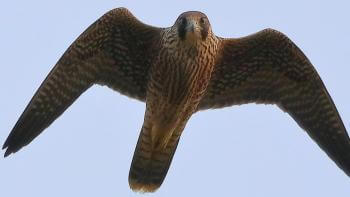
Peregrine falcon
Peregrine falcons also typically migrate north in the winter and south in the summer, but the California-locals prefer to stay here year-round. These creatures are generalists, and can thrive in a range of areas, and are especially known for adapting well to urban environments.
While they’re found in open spaces like Coyote Valley and on coastal cliffsides, they are also found in cities like San José (they invest nest on top of city hall!), showing us that nature isn’t just something outside of city borders – it's all around us!
These raptors are aerial hunters, quickly diving from high altitudes to snatch birds out of the sky, and then immediately getting airborne again.
Fun fact: Peregrine falcons are the fastest animal on earth, clocking in at 240mph.

Prairie falcon
Prairie falcons are obligate grassland hunters, so they can’t live in urban areas the way their peregrine counterparts do, needing open woodlands and grasslands for hunting. They hunt a wide variety of prey, often small mammals like rodents. They have been spotted on all the Open Space Authority’s properties, including the grasslands of Máyyan 'Ooyákma –Coyote Ridge.
These critters are brown on their backs and the tops of their wings and pale with brown markings on the breast and belly.
White-tailed kite
White-tailed kites are another iconic Bay Area raptor. For decades, California has been the primary location of white-tailed kites in North America. These unique birds of prey are characterized by small, hooked beaks, long white wings, and deep red eyes. Thriving in riparian corridors and oak savannas near grasslands, this habitat gives the white-tailed kite the ability to perch in the lightly wooded areas to rest and observe the neighboring grassland.
These birds are known for their unusual hunting technique; “kiting” in mid-air to catch their prey – mainly small mammals.
Did you know: White-tailed kites almost went extinct in the early 19th century, before conservation efforts brought them back to their now flourishing levels.
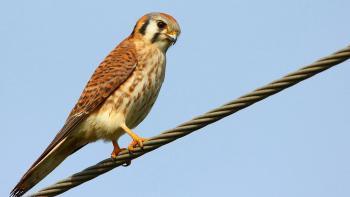
American kestrel
American kestrels are the smallest falcon in the United States, at approximately 9 inches long.
Kestrels are tree-cavity nesters, preferring oak woodlands and edges of grasslands and are thus often found in trees that border agricultural lands.
These falcons are also year-round residents due to California’s stable climate, but in other locations, females often migrate first and grab the best nesting sites for the males to meet them later. If there aren’t breeding pairs, males must fend for themselves.
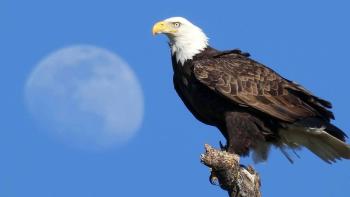
Bald eagle
Bald eagles – America’s national bird – are found in a few locations across Santa Clara Valley. They are well recognized by their brown body and wings, white head and tail, and hooked yellow beak.
These raptors nest in very large trees and make stick nests that get up to six feet wide and three feet deep, and often hunt in open bodies of water. In addition to fish, bald eagles hunt mammals, gulls, and waterfowl.
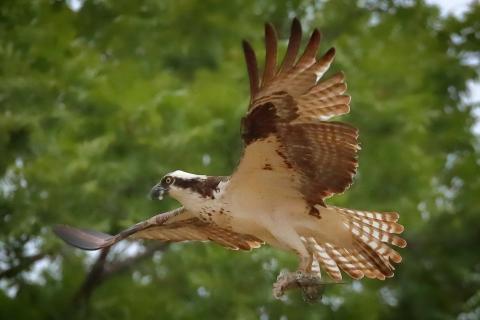
Osprey
Another regal raptor found in the Bay Area is the osprey. Osprey thrive in areas with lakes or deep rivers that make for good fishing, as they eat almost entirely fish. If no lakes or rivers are available, small bodies of water will do.
Often confused with eagles, osprey can be identified by their banded tail and white body.
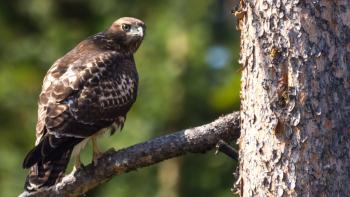
Swainson's hawk
One of the rarer raptors in the area, the Swainson’s hawk isn’t frequently spotted, but can be occasionally seen hunting in open and semi-open country, and nesting in wooded areas.
This broad-winged hawk looks like red-tailed hawks, especially when juveniles, but becomes darker grey as it ages.

Cooper's hawk
Cooper's hawk is an “accipiter,” or a raptor with short, sharp wings best adapted for flying in a woodland environment. These wings help them navigate through densely wooded habitat as they fly.
These critters hunt small mammals, and they build stick nests in trees.
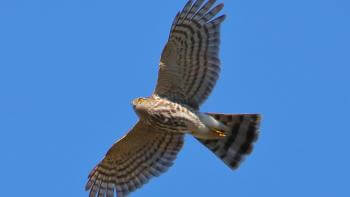
Sharp shinned hawk
Similar to Cooper’s hawk, sharp shinned hawks hunt small mammals in heavily wooded areas.
Looking similar to Cooper’s hawk as well, sharp shinned hawks differ in that they are generally smaller by three to four inches, and have forward, rounded-end wings.
RELATED ARTICLES:
Photo credits: Golden eagle - David Mauk; Ferruginous hawk - David Mauk; Red-tailed hawk - Beth Hamel; Peregrine falcon - David Mauk; Prairie falcon - ; White-tailed kite - David Mauk; American kestrel - David Mauk; Bald eagle - Ron Horii; Osprey - David Mauk; Swainsons hawk - Canva; Coopers hawk - David Mauk; Sharp shinned hawk - David Mauk
